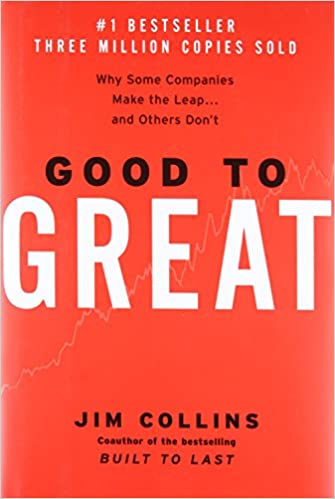originally posted elsewhere: June 10, 2003
tl;dr: An interesting study that conveys some basic business truths...
Collins begins with a fascinating premise: identify those companies that underwent a long-term shift from mediocre/good performance to market-beating great performance, and attempt to explain what they did differently than other companies in the same businesses that did not make the same transition. Thanks to the success of his previous book, Built to Last, Collins was able to assemble a large team of B-school students to do the grunt work, while he could concentrate on organizing the findings and summarizing them in this book.
Collins presents his findings in the chronological order of the steps he feels must be taken to transition from good to great. All in all, his findings will make sense to any student of Peter Drucker's, and they mostly ring true with my own 20 years of experience in the world of business. Collins advocates a very straightforward, fad-avoiding, "stick to your knitting" approach to business, with an emphasis on rational thinking, consistent action, and substance over style. So, the book presents a very strong case that these basic principles can, applied consistently over long periods of time, lead to major success (the good guys win in the end).

That said, I do feel that Collins overreaches a bit. He preaches with the zeal of a true believer, at one point stating "Furthermore, if you ever stop doing any one of the key ideas, your organization will inevitably slide backward toward mediocrity." However, he occasionally bends the facts to fit his theories. After heaping immense praise on Nucor's CEO Ken Iverson (Collins obviously shares Iverson's strict egalitarian philosophy of compensation), Collins explains Nucor's recent troubles by finding one person to claim that Iverson had actually degenerated as a leader. Collins also rails against companies that stray outside their core businesses, but then concocts a questionable core business for the very successful yet highly diversified GE, claiming that its core business is the production of great General Managers to run businesses from aircraft engines to TV broadcasting. But given the challenge of simplifying a very complex world, Collins can be forgiven these minor sins.
The book is an easy read for the busy executive, roughly 200 pages of narrative text divided into bite-sized 20 page chapters. Collins communicates clearly and crisply, and sprinkles in illustrative anecdotes that occasionally tug on emotional heartstrings. Some of his terminology (e.g. "Level 5 Leadership") will no doubt enter the American business lexicon just as BHAG (from "Built to Last") has, although I wish he had chosen a more serious term than "Hedgehog Concept".